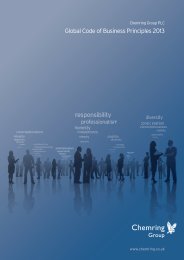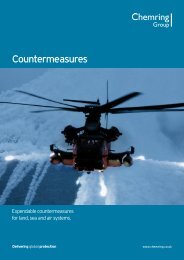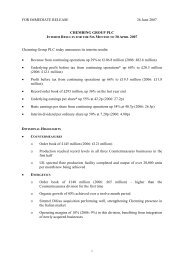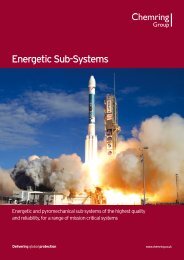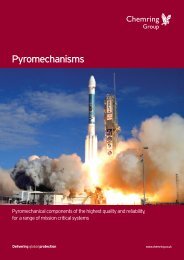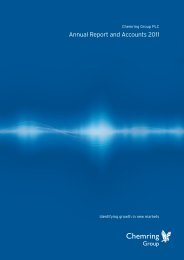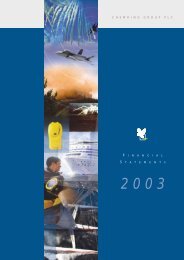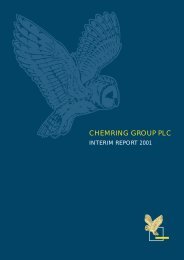Chemring Interim 2006 - Chemring Group PLC
Chemring Interim 2006 - Chemring Group PLC
Chemring Interim 2006 - Chemring Group PLC
Create successful ePaper yourself
Turn your PDF publications into a flip-book with our unique Google optimized e-Paper software.
C H E M R I N G G R O U P P L CNotes to the <strong>Interim</strong> Statement- continued1. ACCOUNTING POLICIES - continuedAs IAS32 and IAS39 are only applied from 1 November 2005, as permitted, the comparative information to 31 October 2005 forderivative financial instruments is presented under UK GAAP FRS13. Under UK GAAP, changes in the fair value of forwardforeign exchange contracts were recognised through the income statement. However, the difference between fair value and bookvalue of the <strong>Group</strong>’s interest rate swaps was not recognised.From 1 November 2005, under IFRS derivative financial instruments are recognised at fair value at the date the derivativecontract is entered into and are revalued at fair value at each balance sheet date. The method by which any gain or loss isrecognised depends on whether the instrument is designated a hedging instrument or not. To be designated as a hedginginstrument the instrument must be documented as such at inception and must be assessed at inception and on an ongoing basisto be highly effective in offsetting changes in fair values or cash flows of hedged items.Hedge accounting principles are used for interest rate swaps and net investment hedges where movements in fair value are held inequity until such time as the underlying amounts of the contract mature. At maturity the amounts held in equity will be recycledto the income statement. Changes in fair value of any ineffective portion of net investment hedges and interest rate swaps arerecognised in the income statement immediately.Where derivatives do not meet the criteria for hedge accounting the changes in fair value are immediately recognised in theincome statement. The <strong>Group</strong> does not apply hedge accounting to the foreign currency forward contracts to mitigate againstcurrency fluctuations. Accordingly gains and losses arising from measuring the contracts at fair value are recognised immediatelyin the income statement.Embedded derivatives that are not closely related to the host contract are treated as separate derivatives with unrealised gains andlosses reported in the income statement.Retirement benefit costsPayments to defined contribution retirement benefit schemes are charged as an expense as they fall due. For defined benefitschemes, the cost of providing benefits is determined using the Projected Unit Credit Method, with actuarial valuations beingcarried out at each balance sheet date. Actuarial gains and losses are recognised in full in the period in which they occur.They are recognised outside profit or loss and presented in the statement of recognised income and expense (SORIE).Past service cost is recognised immediately to the extent that the benefits are already vested, and otherwise is amortised on astraight-line basis over the average period until the benefits become vested.The retirement benefit obligation recognised in the balance sheet represents the present value of the defined benefit obligation asadjusted for unrecognised past service cost, and as reduced by the fair value of scheme assets. Any asset resulting from thiscalculation is limited to past service cost, plus the present value of available refunds and reductions in future contributions to thescheme.Leased assetsWhere the <strong>Group</strong> enters into a lease which entails taking substantially all the risks and rewards of ownership of an asset, the leaseis treated as a finance lease. The asset is recorded in the balance sheet as property, plant and equipment and is depreciated over theshorter of the estimated useful economic life and the lease term. Future instalments under such leases, net of finance charges, areincluded in creditors. The finance element of the instalments is charged to the income statement at a constant rate of charge onthe remaining balance of the obligation.All other leases are operating leases and the rental charges are taken to the income statement on a straight-line basis over the lifeof the lease.Share-based compensationThe <strong>Group</strong> operates equity settled and cash settled share-based compensation schemes.For grants made under the <strong>Group</strong>’s share-based compensation schemes the liability is remeasured at each balance sheet date withchanges in the fair value recognised in the income statement on a straight line basis over the vesting period, based on the <strong>Group</strong>’sestimate of shares that will eventually vest. The valuation of the options utilises a methodology based on the Black-Scholes model.For equity settled share-based grants the total amount recognised is based on the fair value of the equity instrument measured atthe date the award is made. At each balance sheet date the impact of any revision to vesting estimates is recognised in the incomestatement over the vesting period. Proceeds received, net of any directly attributable transaction costs, are credited to share capitaland share premium.For cash settled share-based grants the total amount recognised is based on the fair value of the liability incurred. The fair value ofthe liability is remeasured at each balance sheet date with changes in the fair value recognised in the income statement for the period.P 14



